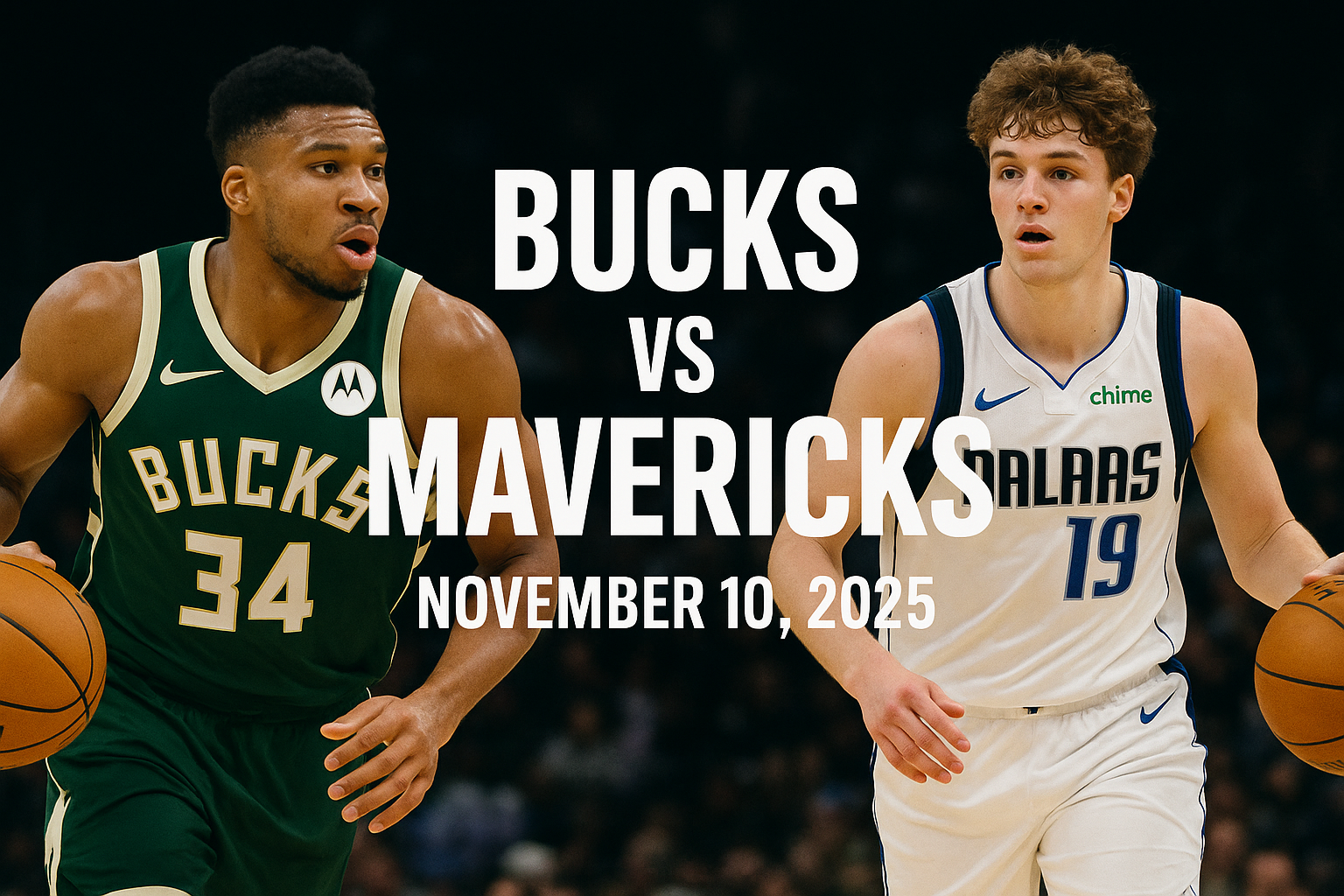Milwaukee Bucks vs Dallas Mavericks: Full Game Analysis, Highlights, and Key Takeaways from the 116-114 Thriller
Introduction
The NBA regular season often brings unpredictability, excitement and match-ups that live beyond the box score. One such game was the recent meeting between the Milwaukee Bucks and Dallas Mavericks, played on November 10, 2025, that delivered a tightly contested finish and plenty of storylines. The Bucks edged the Mavericks 116-114, a two-point win that hides a lot of drama, momentum swings and individual narratives. Action Network+3Brew Hoop+3Sofascore+3
In this article, we’ll break down all the layers of this game: the context, the rosters, the key moments, what went right (and wrong) for each team, and what this means moving forward — both for Milwaukee and Dallas. I’ll also bring in a human touch: the mental swings, the pressure, the near-misses and how these players and teams responded.
Setting the stage: where both teams stood
Milwaukee Bucks
The Bucks entered this matchup with a decent start to the season. They were 6-4 (or 7-4 after this game depending on source) at that point. NBA+3Action Network+3Sofascore+3 With star power, experience and a desire to build momentum, Milwaukee looked to assert their standing as a contender.
Key points for Milwaukee:
-
Their superstar, Giannis Antetokounmpo, was listed as probable with a knee issue. The Times of India+1
-
The Bucks coaching staff and roster experience gave them a psychological edge — they know how to win tight ones.
-
They faced a Dallas team that was undermanned, giving the Bucks an opportunity.
Dallas Mavericks
The Mavericks, on the other hand, were in a rough patch. Their start was 3-7 before the game. Mavs Moneyball+1 They were coping with injuries and looking to find some rhythm.
Key issues for Dallas:
-
Several bigs and key players were out. The Times of India+1
-
Their offense was struggling. One preview noted: the Mavericks were the second-worst half-court offense in the league. Action Network
-
But there was a glimmer of hope: younger players stepping up, and a hunger to prove themselves.
So entering this game, Milwaukee was the favorite — but Dallas had nothing to lose and plenty to gain.
The Game Flow: Quarter by Quarter
The ebb and flow of the game tell much of the story. Let’s walk through how it unfolded, then reflect on moments that mattered.
First Quarter:
Milwaukee jumped out with a lead early, showing aggressiveness. But Dallas fought back, and by the end of the first quarter the Mavericks held a 31-27 advantage. Sofascore+1
What this tells us: Dallas came out alive, not simply content to roll over. Milwaukee’s start was decent but they allowed Dallas to build momentum.
Second Quarter:
Milwaukee begins to claw back. Dallas still looks solid, but the Bucks start finding bits of rhythm. At halftime, the Mavericks held a slim lead: 57-53. Mavs Moneyball
Importantly, Giannis had been effectively contained for much of the half: the Mavericks kept the paint crowded when he tried to attack. Mavs Moneyball
Third Quarter:
The pivotal leg of the game. Dallas extended and looked like they might take control. At one point they built a double-digit lead (about +10) behind solid two-way play from youngsters like Cooper Flagg. Flagg had a standout game. Mavs Moneyball+1
But Milwaukee refused to fold. Crucially they chipped away, made stops and found ways to get back into it.
Fourth Quarter & Climax:
Here’s where the human drama kicks in. Milwaukee, with Giannis leading the way emotionally and physically, made the final push. They erased the deficit and eventually took the lead late. Dallas had opportunities, including at the free-throw line, to tie. But they couldn’t convert. Milwaukee held on to win 116-114. Brew Hoop+2Sofascore+2
The margin is small but the significance is big. For Milwaukee, it’s resilience and closing ability. For Dallas, it’s heartbreak and “what-could-have-been”.
Key Performers & Storylines
Let’s zoom in on individual and team narratives that defined the contest.
Milwaukee Bucks
-
Giannis Antetokounmpo: He was effective when it counted. Despite being somewhat contained early, he saved his legs for the finish, especially the fourth quarter. From the recap: “he found enough space to score 15 of his game-high 30 points in the fourth quarter.” Mavs Moneyball
-
The supporting cast: Players like Kyle Kuzma, Bobby Portis and others stepped up — sharing the load, hitting big shots, making defensive plays.
-
Mental strength: The Bucks’ ability to wrestle control in the final minutes speaks to their experience and mindset. When things got chaotic, they got better.
Dallas Mavericks
-
Cooper Flagg: A breakout performance. He scored 26 points and grabbed nine rebounds. He had that youthful energy, the fearlessness on the big stage. Mavs Moneyball
-
Supporting-cast contributions: Players like P.J. Washington, Brandon Williams and Moussa Cissé made meaningful contributions, especially defensively and in transition. Mavs Moneyball
-
The missed chance: Dallas was in a position to win. They had the lead. They executed for stretches. But when a team like the Bucks makes their run and you falter at the line, you feel it. P.J. Washington’s missed free throws in the final second loomed large. Mavs Moneyball
Tactical & Strategic Themes
Here are a few of the deeper tactical undercurrents that defined the game.
Paint dominance vs perimeter pressure
One of the Bucks’ strengths is their ability to dominate inside, around the rim, and in transition. The Mavericks recognized this and tried to pack the paint, clog the lane, and force Milwaukee to settle for jumpers. As noted: Giannis didn’t even attempt a shot until late in the first half. Mavs Moneyball
However, the Bucks adjusted. They found ways to get Khris, Kuzma, Portis—and Giannis himself—into the flow. The inside-out shift helped.
Young Mavericks trying to establish identity
Dallas is trying to build something. With injuries and roster changes, this is as much about process as outcome. The young guys (Flagg, Williams, Cissé) are given freedom. Their pace, their transition scoring, their energy – that is a foundation. But they still need the finishing instincts and composure in tight moments, which is harder to develop overnight.
Game management and closing ability
Milwaukee’s win is in large part due to their experience in managing late-game pressure: knowing when to take a quick shot, when to slow things down, when to defend transition, when to rebound free-throws. Dallas had these moments too, but lacked that final bit of composure. That gap often separates contenders from hopefuls.
Injuries / roster stability
Dallas was hampered by absences. Milwaukee had Giannis listed as probable, which always raises an eyebrow in terms of how fresh/healthy he is. The Times of India When one team is fully stocked (relatively) and the other is patching things together, those extra minutes, the bench depth, the coaching continuity all matter.
What Went Right / Wrong for Each Team
Bucks – What Went Right:
-
They overcame slow stretches. For large parts of the first half, they were being held in check, but they stayed patient.
-
Closing strong. The fourth quarter of this game belonged to the Bucks.
-
Experience and poise. In tight games, the Bucks showed resilience.
-
Balanced scoring. While Giannis led, others delivered when needed.
Bucks – What Went Wrong or Could Improve:
-
The slow start and difficulty getting Giannis going early may be a concern if they face fresher teams.
-
Their defensive rebounding (specifically 2nd-chance opportunities) is something to watch. The recap noted Milwaukee was out-rebounded offensively late. Brew Hoop
-
Dependence on late run. Would prefer more sustained control rather than letting it become a coin-flip in the closing minutes.
Mavericks – What Went Right:
-
Effort and hunger. The Mavericks showed fight, especially given their injuries.
-
Young players stepping up: Flagg’s breakout, Williams, Cissé all gave reasons for hope.
-
Running in transition and creating opportunities off turnovers. That looked sharp at times.
Mavericks – What Went Wrong:
-
Missed opportunities. Leading in the fourth, having the ball with time, and still losing – that burns.
-
Free throw trouble in the clutch (Washington at line). Execution in finish-line moments is still a weakness.
-
Offensive stagnation earlier in the game. The game story: they built the lead but let it slip. Milwaukee adjusted, and Dallas couldn’t re-establish control.
Bigger Picture: Why This Game Matters
Games like this aren’t just regular season checkboxes. They signal trajectories. Here’s why this specific matchup has meaning:
-
Momentum: For Milwaukee, winning a close one adds bounce. It reinforces belief. For Dallas, a loss like this (when you were in it) can hurt morale, unless you frame it as experience gained.
-
Identity building: Dallas is trying to develop identity. By pushing the Bucks to the edge, they see they can play with anyone – if they tighten up a few things. Milwaukee is reaffirming their identity: finish strong, lean on your stars, don’t panic.
-
For fans and market: Close, exciting games bring attention. In markets like Dallas and Milwaukee, this adds value.
-
Injury & stamina test: These games show you how teams handle adversity (injuries, back-to-backs, travel). For example, if Giannis was playing after a questionable tag and still delivered, that says something.
Implications & What to Watch Moving Forward
For the Bucks:
-
Monitor Giannis’s health and how his body responds over a stretch. If he’s not 100%, can the supporting cast handle bigger burdens?
-
Will the Bucks try to start games stronger, so they’re not relying on late surges too often?
-
How will their defense hold up against different styles (faster teams, more three-point reliant squads)? They showed strength here but there’s room to tighten.
For the Mavericks:
-
Can they clean up late-game execution? Free throws, simple plays, managing leads.
-
Will the young players continue to grow and translate flashes into consistency? Flagg in this game looked like a piece; the question is, will he keep evolving?
-
Can they get healthier and find rotation stability? Injuries have clouded their early season. Getting core players healthy, or adjusting accordingly, will be essential.
-
Offensive creativity: Can the Mavericks move beyond transition bursts and build half-court sets that punish defenses like the Bucks?
A Human Touch: Emotion, Pressure & Growth
One of the things I love most about matchups like this is how they expose the emotional side of basketball: the hope, the frustration, the late-night fatigue, the “oh-so-close” moment that lingers.
For Dallas, think of Cooper Flagg: a young talent stepping into the spotlight, performing with energy and drive. That 26-point, nine-rebound line doesn’t just tell us he scored— it says he believed he belonged. But after the game, I imagine the weight of the loss sets in: you feel you should’ve had it. That feeling — when you were so close — can sting, or it can ignite something bigger. The Mavericks will hope it’s the latter.
For Milwaukee, the narrative is different but equally human. Giannis, carrying the burden of expectation, perhaps not fully 100 %, still finds ways to show up. The veterans around him — Kuzma, Portis, the role players — when the game is tight, you see them step up. It’s not just skill, it’s mental toughness. It’s believing in the moment when the clock is ticking.
And for the fans in both cities: the electricity of a two-point finish, the flip of momentum, the hope of a comeback or upset — that’s what makes sports worth staying up for, even across time zones (especially if you’re following from India!). This game had that spark.
Final Thoughts
The Bucks-Mavericks game of November 10, 2025 will likely be remembered more for its tension and significance than for style or blowout dominance. It was a game of inches and seconds, of youth versus experience, of resilience versus mis-execution. The 116-114 scoreline tells you how tight it was—but doesn’t fully tell you the emotional output, the tactical shifts, the implications behind the scenes.
For Milwaukee, this win confirms they remain a force, capable of grinding out tough games. For Dallas, this loss, while tough, offers a teaching moment. They’re showing signs of growth, of promise, but also the gaps they must close to truly contend.






